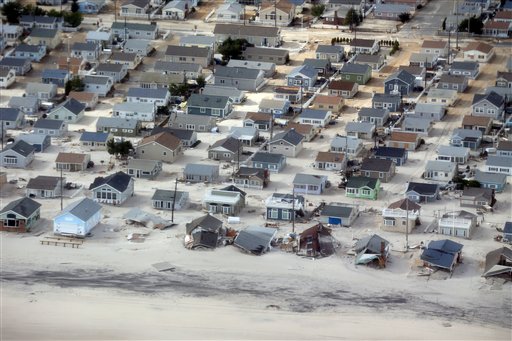By MARYCLAIRE DALE and WAYNE PARRY
Associated Press
MANTOLOKING, N.J.
New Jersey’s delicate barrier islands, long and slender strips of land cherished by generations of sunbathing vacationers and full-time residents alike, are a hazardous wasteland of badly eroded shore, ruined beachfront homes, flooded streets and damaged utilities.
The full extent of the devastation on the island that hosts MTV’s “Jersey Shore” came into sharper focus Wednesday, and it wasn’t a pretty sight. Signs of the good life that had defined wealthy enclaves like Bayhead and Mantoloking lie scattered and broken: $3,000 barbecue grills buried beneath the sand and hot tubs cracked and filled with seawater.
Nearly all the homes were seriously damaged, and many were destroyed – no trace of them left.
New Jersey got the brunt of superstorm Sandy, which made landfall in the state and killed six people here. More than 2 million customers were without power as of Wednesday afternoon, down from a peak of 2.7 million.
Some parts of the shore might never look the same, Gov. Chris Christie said.
The governor joined President Barack Obama aboard Marine One on Wednesday afternoon for an aerial tour of the storm damage along the shore, the economic engine that powers New Jersey’s $35.5 billion tourism industry.
Nearly 48 hours after Sandy made landfall, the most densely populated state in the nation was still very much in a state of emergency.
Most mass transit systems were shut down, leaving hundreds of thousands of commuters braving clogged highways and quarter-mile lines at gas stations. Closed, too, were Atlantic City’s casinos. And Christie postponed Halloween until Monday, saying trick-or-treating wasn’t safe in towns with flooded and darkened streets, fallen trees and downed power lines.
Nearly 20,000 residents were stranded in Hoboken, just across the Hudson River from Manhattan, amid accusations that officials have been slow to deliver food and water. One man blew up an air mattress and floated to City Hall, demanding to know why supplies hadn’t gotten out. Public Safety Director Jon Tooke defended the city’s response, saying at least 25 percent of Hoboken remained under water and emergency personnel and the National Guard are working round-the-clock.
On the opposite end of the state, hairdresser Robert Dennis desperately tried to flag a ride out of Atlantic City to work in Pleasantville, several miles away. His car was flooded and taxis wouldn’t take him because they can’t get back in.
In Little Egg Harbor Township, a coastal community bordering the southern end of Long Beach Island, streets and yards were clogged with battered pleasure craft – and the docks they had been tied to. Residents still had at least 2 feet of water in their homes.
New Jersey has 127 miles of Atlantic Ocean shoreline. Most of the beach destinations, including famed spots like Seaside Heights, Atlantic City and Wildwood, are on barrier islands that range in width from a few hundred feet to a couple of miles. The islands are so narrow that bay met ocean during the height of the storm, with water covering entire islands and making a mockery of the sandbags that some had placed around their homes.
Conditions were still too hazardous Wednesday to allow residents back on Long Beach Island, where cars were buried in 5 feet of sand, crews used heavy equipment to clear the roads and National Guard members went door-to-door, checking on residents who stayed.
Residents were turned away from the barrier island just to the north, too. At the bridge, Toms River police Chief Michael Mastronardy told them homes were destroyed, power lines were down and the area smelled like natural gas.
Kathy Kirkof was hoping to get back to her home in the Ortley Beach section of Toms River, just north of Seaside Heights.
Ortley Beach and Seaside Heights both took a heavy blow. A truck stuck out of a sinkhole, houses were on their sides and pushed into the main road and huge piles of sand stood blocks from the ocean.
Police were making anyone still there clear out.
Long Beach Island and its northern neighbor still lacked sewer service, water, gas and electricity. The stench of natural gas hung in the air, indicating broken lines.
In Brick Township, as many as 10 homes caught fire during the storm when they were knocked from their foundations, rupturing gas lines, said Brick Township police Sgt. Keith Reinhard. Gas still jetted from the broken lines Wednesday, and about 25 fires burned.
One bright spot: Newer oceanfront homes built on 35-foot pilings did what they were supposed to do as upper floors remained intact, though many were damaged. About a dozen older homes were swept off their foundations, according to Long Beach Township Mayor Joe Mancini.
Some residents believe that beach replenishment projects that built up the dunes protected the southern end of Long Beach Island.
To the north, in Mantoloking, residents weren’t feeling so lucky.
Peter Green said a neighbor told him she saw a group of kids carrying away golf clubs they had stolen from his wrecked home.
Police appeared to be doing what they could to protect the damaged multimillion-dollar homes.
A police officer patrolled the sand and questioned a group of kids with backpacks, asking if they’d taken anything. They said no, and their father vouched for them.
A passer-by then asked the officer, “Is this Mantoloking?”
___
Dale reported from Long Beach Island. Associated Press writers Katie Zezima in Little Egg Harbor Township and Seaside Heights, Shawn Marsh and Geoff Mulvihill in Trenton, Samantha Henry in Hoboken, David Porter in Newark and Michael Rubinkam contributed to this story.

COMMENTS
Please let us know if you're having issues with commenting.